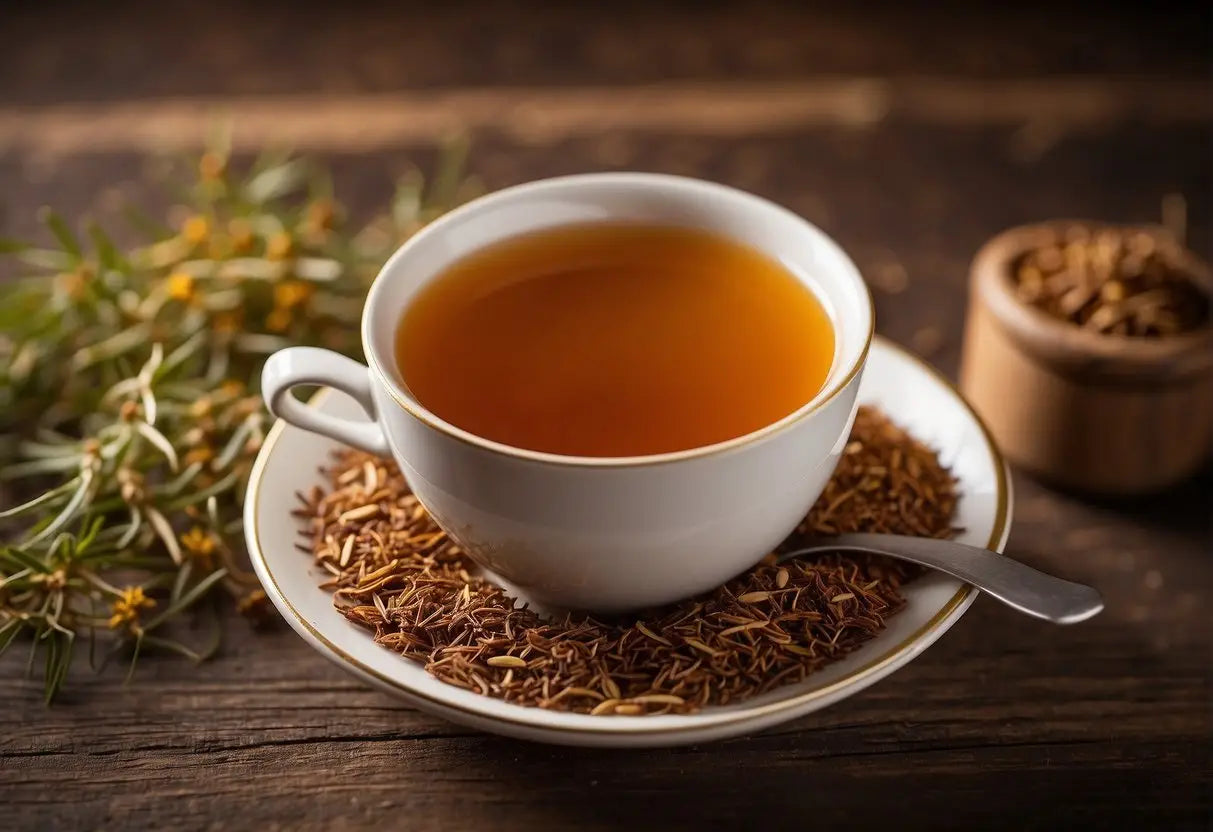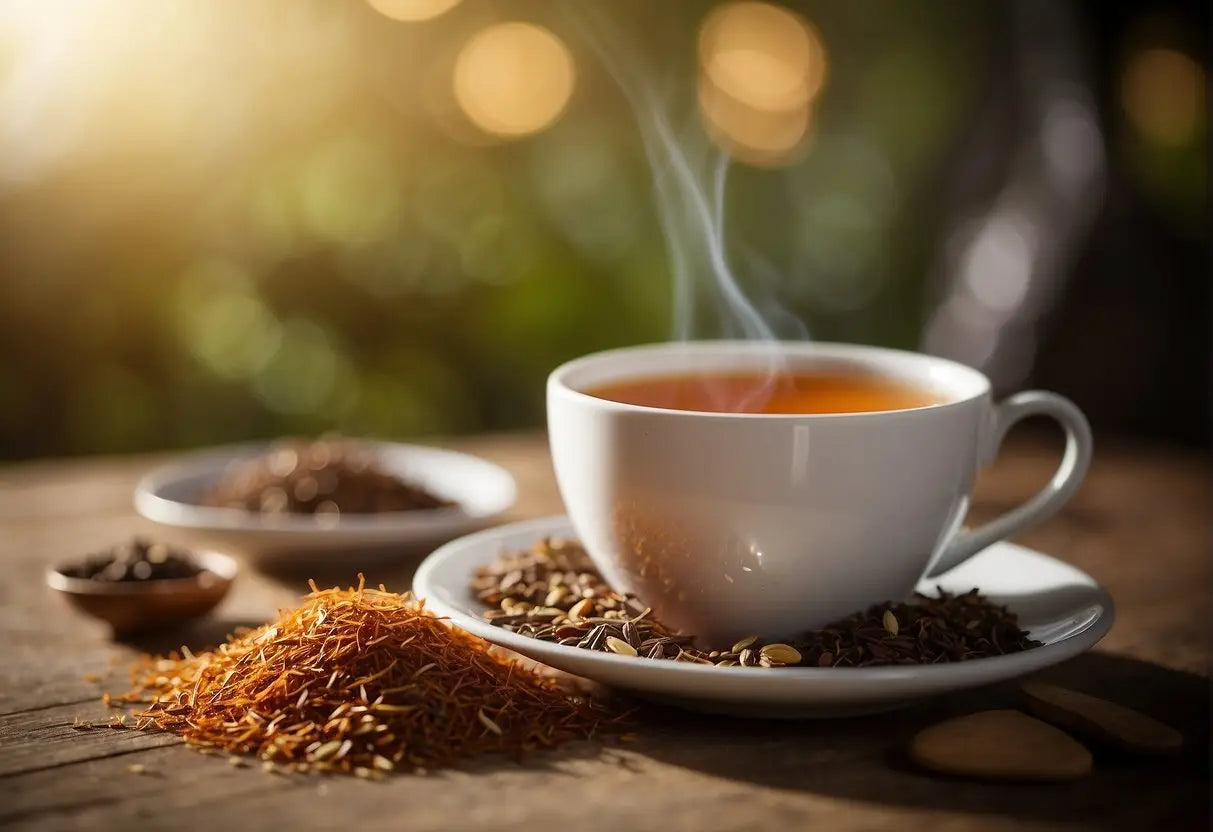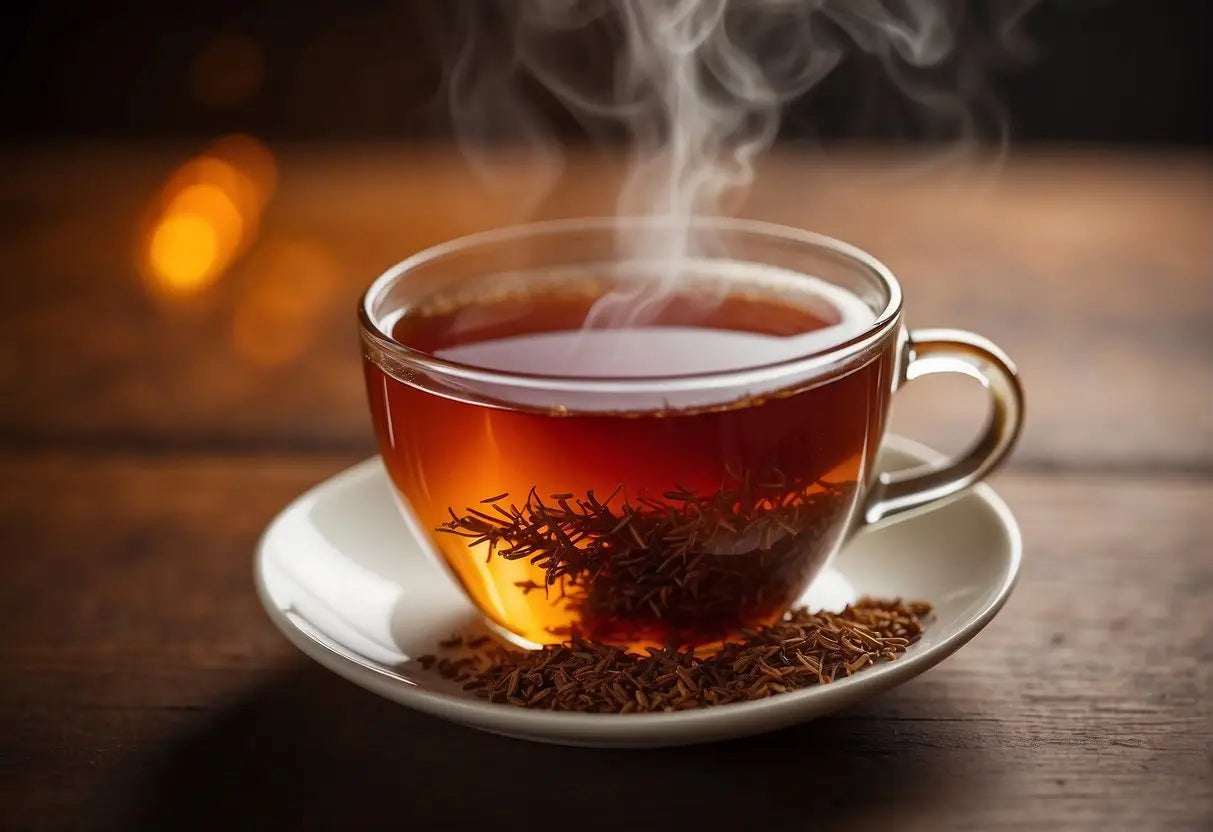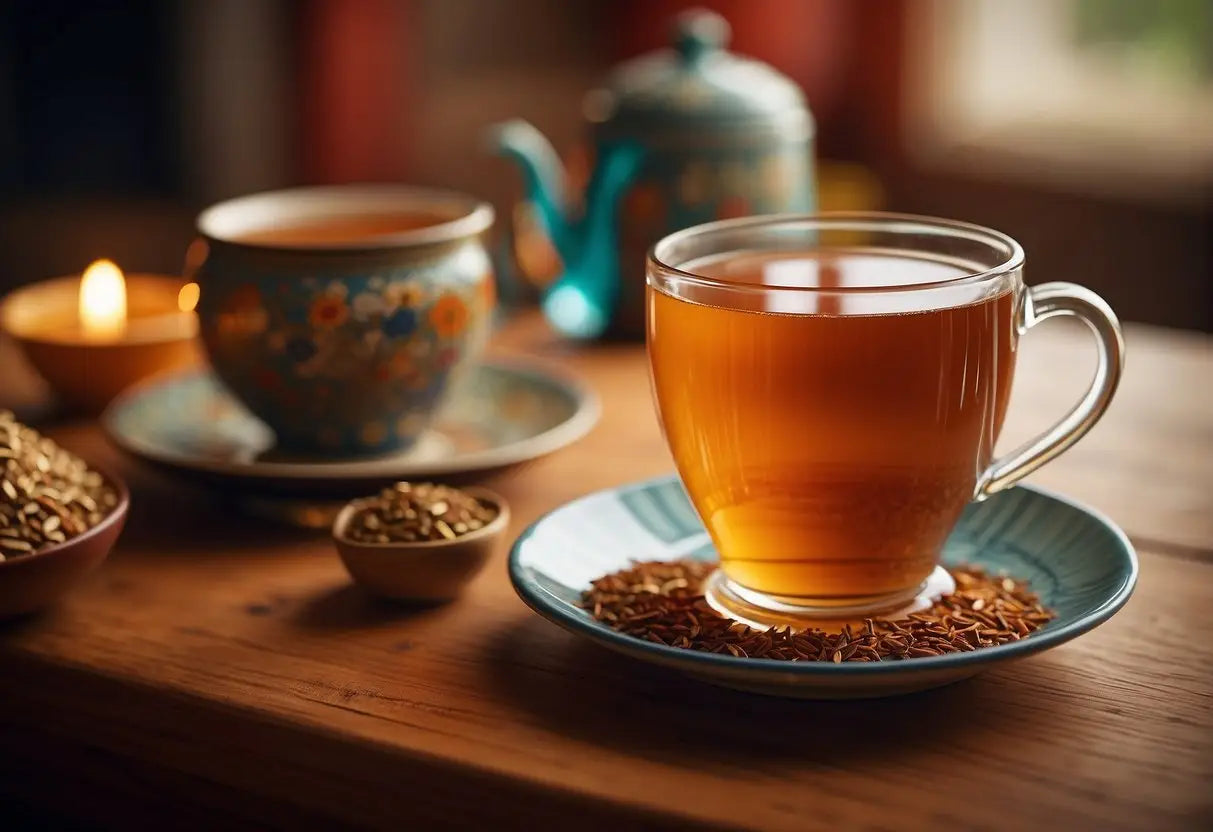What Does Rooibos Tea Taste Like
Rooibos tea, originating from South Africa, presents a unique taste that distinguishes it from other herbal teas. Its flavor is often described as naturally sweet and fruity with a hint of nutty undertones.
Here are the key notes you might detect when sipping rooibos tea:
- Sweetness: Unlike many teas, you won't need to add sugar to rooibos tea due to its inherent sweetness.
- Fruity Elements: Expect to sense a light peach or apricot-like quality in your cup.
- Earthy Nuances: Rooibos can have a gentle, earthy base that adds depth to its profile.
- Nutty Accents: Almond and hazelnut notes can sometimes be found in the complexity of its flavor.
When brewed, the tea boasts a red-amber color, offering a visual hint at its rich and warm character. Your palate will appreciate the absence of bitter tannins commonly found in black or green teas, which contributes to rooibos' smooth finish. The overall experience is soothing and can be enjoyed at any time of the day, as rooibos is naturally caffeine-free.
Bestsellers
Texture:
- The mouthfeel of rooibos tea is generally smooth and round, adding to the comforting drinking experience.
Remember, the flavor can vary slightly depending on the brand and how the tea is prepared. For optimal taste, steep rooibos tea for five to seven minutes using freshly boiled water.
Primary Taste Characteristics

Rooibos tea provides a unique taste experience. It exhibits a natural sweetness, earthy notes, and fruity undertones that combine to offer a refreshing beverage.
Sweetness
Rooibos tea is naturally sweet, reducing the need for added sugar. Its sweetness is subtle and pleasant, reminiscent of honey or vanilla.
Earthy Notes
The earthiness in rooibos tea gives it a grounding quality. You'll notice hints of wood or nuts that provide a rich, full-bodied flavor.
Fruity Undertones
Finally, rooibos can carry a gentle fruity undertone. This may range from light citrus hints to more pronounced notes similar to berries, contributing to its complexity.
Comparison With Other Teas

When you explore the taste of rooibos tea, it's useful to compare it to other popular teas. This helps you understand its unique flavor profile.
Rooibos vs Black Tea
Rooibos tea has a naturally sweet and nutty flavor, often with hints of caramel and vanilla. It lacks the astringency common in black tea and does not become bitter when steeped for a long time. In contrast, black tea is known for its bold and robust taste, which can become bitter if over-brewed.
- Rooibos: Naturally sweet, nutty, no bitterness
- Black Tea: Bold, robust, can become bitter
Rooibos vs Green Tea
Unlike green tea, which can have a grassy and fresh flavor, rooibos is more earthy and rich, without the vegetal notes. Rooibos also does not contain caffeine, which is present in all green tea varieties.
- Rooibos: Earthy, rich, caffeine-free
- Green Tea: Grassy, fresh, contains caffeine
Rooibos vs Herbal Teas
Herbal teas encompass a broad range of flavors, but rooibos stands out due to its lack of bitterness and subtle sweetness not often found in other herbal teas. It also blends well with other flavors, which is why it's frequently used as a base for flavored herbal blends.
Lao Ban Zhang
- Rooibos: No bitterness, subtly sweet, versatile for blending
- Herbal Teas: Broad range, varying sweetness, less suitable as a base for blending
Factors Affecting Flavor

The flavor of rooibos tea can vary considerably based on growing conditions, how it's processed, and the way you prepare it.
Growing Conditions
Rooibos tea is cultivated primarily in the Cederberg region of South Africa. The unique environment, characterized by hot, dry summers and sandy soil, is essential to its distinct flavor profile. Key factors include:
- Altitude: Higher altitudes may result in a slight increase in antioxidant content which can subtly influence flavor.
- Climate: Rooibos grows best in a climate with lots of sunshine and low rainfall, affecting its sweetness and full-bodied taste.
Fermentation Process
The fermentation process is responsible for the characteristic color and flavor of rooibos tea. Fermentation involves:
- Oxidation: Unfermented rooibos, often called green rooibos, has a lighter, grassy taste. Traditional, fermented rooibos boasts a rich, earthy vanilla flavor.
- Duration: The length of time for oxidation can enhance sweetness and reduce bitterness, affecting the intensity of the flavor.
Preparation Methods
Your method of preparation plays a crucial role in the flavor of the end product. Consider these factors:
- Water Temperature: Rooibos is best brewed with fully boiling water (212°F or 100°C); different temperatures can change the infusion strength.
- Steeping Time: A longer steep extracts more flavor, but steeping beyond 5-7 minutes might lead to a more astringent taste.
Health Benefits and Flavor Link

Rooibos tea, often referred to as red bush tea, presents a unique flavor profile that is intrinsically tied to its health benefits. When you sip rooibos, you're greeted by a naturally sweet and nutty taste, with hints of caramel and vanilla. The absence of caffeine in rooibos tea might be surprising, given its rich and full-bodied essence.
Flavor Characteristics:
- Sweet: The natural sweetness reduces the need for added sugars.
- Nutty: Provides a comforting and warm drinking experience.
- Caramel: Adds a richness that is both indulgent and soothing.
- Vanilla: Offers a subtle, gentle complexity to the flavor.
The health benefits of rooibos tea arise from its rich content of antioxidants such as aspalathin and nothofagin. These antioxidants are significant for your health: they help combat inflammation and protect your cells against free radicals. Here's how they link to the flavor:
| Antioxidant | Potential Health Benefit | Flavor Influence |
|---|---|---|
| Aspalathin | Balances blood sugar | Adds sweetness |
| Nothofagin | Supports brain health | Contributes to nuttiness |
You will find rooibos tea's mineral content—such as magnesium for nervous system support and calcium for strong bones—is another benefactor to your health without impacting the taste. This subtle interaction between flavor and health supports the notion that enjoying rooibos tea is both a pleasurable and beneficial experience.
Pairing Foods with Rooibos Tea

When you indulge in rooibos tea, consider complementing it with food that enhances its naturally sweet and nutty flavor profile. Your pairing choice can elevate the tasting experience.
Sweet Treats:
- Chocolate: The richness of dark chocolate contrasts pleasantly with the tea's sweetness.
- Vanilla-flavored desserts: Vanilla's creamy notes echo rooibos's smoothness.
Savory Selections:
- Cheese: Aged cheese like Gouda pairs well, the creaminess complements the tea's slight tang.
- Spiced Dishes: The tea's hint of spice aligns with mildly spiced curries or stews.
Baked Goods:
- Scones: Top them with clotted cream and fruit preserve.
- Biscotti: The crispy treat can be dipped into the tea for added moisture.
Herbal Infusions:
- Experiment by adding herbs like cinnamon or ginger to align with rooibos's natural notes.
When selecting your food pairings, you should take into account the time of day and your personal taste preferences. Morning pairings might lean towards baked goods, while evening sips could accompany richer desserts or savory dishes. Remember, the aim is to both contrast and compliment the rooibos tea's unique flavor without overpowering it.
Varieties of Rooibos Tea

Rooibos tea, a South African herbal beverage, is available in two distinct forms: the traditional, red variety and the less common, green variety. Each offers a unique flavor profile and set of characteristics.
Traditional Rooibos
Traditional rooibos tea is fermented and then dried, which gives it a deep red color. Its flavor is often described as sweet and slightly nutty, with hints of caramel, vanilla and a smoky undertone. Unlike green or black teas, it has a low tannin content, which means it's less likely to be bitter and can be steeped for a longer time without compromising its mellow taste. Traditional rooibos is also caffeine-free, making it a popular choice for any time of the day.
Green Rooibos
On the other hand, green rooibos tea is unfermented, which results in a lighter-bodied tea with a grassy, herbal taste that's reminiscent of green tea but with sweeter notes. The preservation of more antioxidants during its minimal processing makes it a choice for those looking for a tea rich in health benefits. Green rooibos also retains a natural, light green or yellow color and shares the caffeine-free quality of its traditional counterpart.
Cultural Context and Flavor Perception

When you sip rooibos tea, your experience of its flavor is not just about your taste buds—it's also influenced by your cultural background. This naturally caffeine-free tea comes from the Aspalathus linearis plant, native to South Africa's fynbos biome. For generations, it has been consumed by the local people and is now enjoyed worldwide.
- Cultural Background: Your own culinary traditions may affect how you perceive rooibos tea. If you frequently enjoy robust, full-bodied beverages, the delicate sweetness of rooibos might come across as subtle or nuanced.
-
Taste Description:
- Sweet: Rooibos often carries a natural sweetness.
- Nutty: Some drinkers detect hints of hazelnut or almond.
- Earthy*: Reflecting its South African origins, an earthy quality can be noted.
- Fruity: Undertones of fruitiness can vary depending on the specific blend or harvest.
Whether you're new to rooibos or a long-time enthusiast, keep in mind that your personal flavor perception is unique. You may pick up on different notes than others. The table below summarizes the common flavor profiles of rooibos tea depending on your previous exposure to varying flavors.
| Taste Attribute | Familiar Tastes Similar | Unfamiliar Tastes Similar |
|---|---|---|
| Sweet | Honey, Caramel | Sweet Herbs, Dates |
| Nutty | Hazelnut, Almond | Amaretto, Malty Notes |
| Earthy | Beets, Mushrooms | Wet Leaves, Tobacco |
| Fruity | Ripe Berries, Citrus | Hibiscus, Stone Fruits |
Your cultural context sets certain expectations and can prime you to notice specific flavors in rooibos tea. However neutral your palate may be, it's an incredibly personal and subjective experience that is shaped by your individual gustatory journey.
Frequently Asked Questions

In this section, you'll find concise and informative answers to some of the most common questions about rooibos tea, including its taste, health benefits, caffeine content, and more.
How would you describe the flavor profile of rooibos tea?
Rooibos tea typically offers a sweet, nutty flavor with hints of caramel, vanilla, and a smoky undertone. It's known for its natural sweetness and lack of bitterness compared to other teas.
What are some potential health benefits associated with drinking rooibos tea?
Drinking rooibos tea may have several health benefits, including antioxidant effects, potential support for heart health, and possibly aiding in blood sugar regulation. It's also hydrating and can be a healthful addition to your daily fluid intake.
Are there any side effects of consuming rooibos tea one should be aware of?
Rooibos tea is generally considered safe with few known side effects. However, excessive consumption may lead to liver issues or hormonal disturbances. Always enjoy it in moderation, and consult with a healthcare provider if you have existing health concerns.
Is there any caffeine content in rooibos tea?
Rooibos tea is naturally caffeine-free, making it an enjoyable option for those seeking a warm beverage without the stimulating effects of caffeine.
Can drinking rooibos tea induce relaxation or sleepiness?
The lack of caffeine in rooibos tea makes it a popular choice for promoting relaxation. Anecdotal evidence suggests that it might help improve sleep quality, though robust scientific data is limited.
How does rooibos tea compare to other teas in terms of taste?
Compared to green or black teas, rooibos tea is less astringent and has a sweeter, fuller-bodied flavor. Unlike many teas, it doesn't turn bitter with prolonged steeping, which makes it favorable for those who prefer a milder taste profile.
← Older post Newer post →











